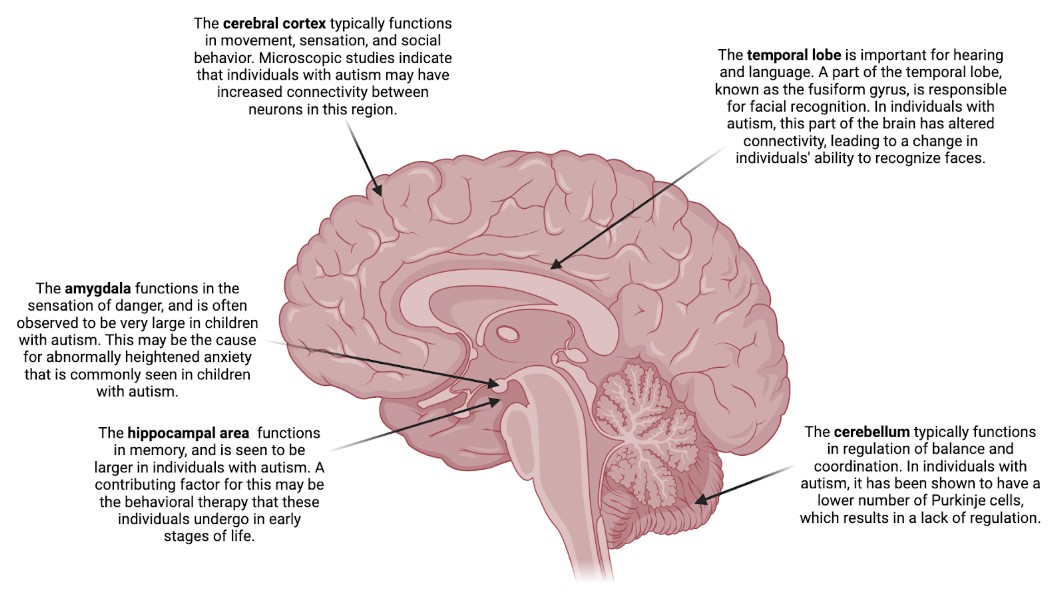Unraveling the Enigma: A Journey into Autism Spectrum Disorder

Published on September 6, 2023
Thump. Thump. Thump. Thump. Each beat from the speaker resonates in your skull, shaking it from its very core. Nothing but thumps. Your brain rattles, thumps thumping in your head, bouncing around, refusing to escape. Speaking, music, footsteps, you bring your hands to your ears to block them out, to muffle the cacophony reverberating against your eardrums, but it doesn’t matter what the sound is, it’s just too loud. The lights are blinding, searing into your eyes like a million suns directed straight into your retinas. You claw at them, in a desperate attempt to save your sight, but it doesn’t matter; it’s just too bright. You try to move your tongue, vibrate your vocal cords to speak, but words won’t come out, or if they do, nobody understands you. In front of the blinding lights, their voices boom out, ridiculing you for your inability to communicate like the others, conforming to the societal standards of “normal”. No matter how hard you try, it’s an unsurmountable wall, and you’ll never be this kind of “normal”.
For some, this is no lucid dream or nightmare, but a glimpse into their unique sensory experiences. Autism Spectrum Disorder (ASD) is now one of the most common neurodevelopmental disorders, with one in 36 children being diagnosed with it as of 2020. However, it is important to note that ASD is an umbrella term and that individuals are affected by much more nuanced disorders, some of the most common being autism disorder, Asperger’s Syndrome, and Pervasive Developmental Disorders Not Otherwise Specified (PDD-NOS). The symptoms for each of these disorders are different, and different individuals experience these to different degrees as well. ASD is exactly as it sounds—on a spectrum. For example, individuals with autism disorder are often diagnosed with difficulty in verbal and non-verbal communication, as well as delayed language, movement, and cognitive/learning skills, while those with Asperger’s are generally affected by a lack of social communication, similar to autism disorder but generally without any intellectual disabilities. Pervasive Developmental Disorders Not Otherwise Specified were originally considered a subtype of autism, but were rebranded to ASD in 2013 with the publication of the DSM-5 (Diagnostic Statistical Manual of Mental Disorders, Fifth Edition). Individuals experiencing ASD exhibit a variety of symptoms, which vary depending on which parts of the brain are affected. Here’s a figure that describes some of these brain alterations:

The earliest documented case of ASD is somewhat of a controversial topic. Some consider it the case of a young boy named Victor in 1899, where renowned physician Dr. Jean Itard came across a boy in a forest, appearing to be deaf to communication, exhibiting repetitive behavior, and a lack of communicative abilities. Others consider it to be Donald Triplett, diagnosed in 1938 by Dr. Leo Kanner, who was the first to describe Triplett’s disorder as “autistic”. After his diagnosis, Triplett went on to live a life where he was accepted and supported, dying only recently in June of 2023, three months ago as of the writing of this blog post. We are unsure of who succeeds him, but his life has been documented and commemorated in the documentary “In a Different Key”. The history of ASD, however, has been rife with controversy, some more disconcerting than others. Hans Asperger, whose namesake is Asperger’s Syndrome, knowingly referred children to mental institutions in Austria controlled by Nazi Germany known for murdering their patients; many of the children he referred were murdered, making Asperger complicit in Nazi Germany’s killing machine. Despite his actions, Asperger then went on to coin the disorder he observed in children after himself, Asperger’s Syndrome, a name still used today.
Despite the decades of research done on ASD (started off by Hans Asperger), researchers are nowhere near developing treatments or even finding a root cause behind the disorder. Some researchers and their labs at UNC, such as Dr. Jason Stein (interviewed in Episode 2) are currently actively working towards determining mechanisms behind certain aspects of ASD, such as cortical hyper expansion. One of Dr. Stein’s projects specifically uses brain organoids grown from induced pluripotent stem cells (iPSCs) derived from blood samples of patients of ASD, their family members, and those not affected by ASD. By using brain organoids, researchers hope to model a brain with ASD much better than any mouse model can, providing huge insights into the disorder. Other prominent research in the field includes the Center for Disease Control’s (CDC’s) SEED (Study to Explore Early Development), a multi-year multi-site study to learn about ASD and other developmental disabilities in children. It is considered one of the largest studies in America involving ASD and has made significant progress with its work. It has contributed monumental discoveries to the field of ASD research, including the discovery that ASD does not have a singular contributing factor, but rather has a multifactorial origin, including infections with fever during the second or third trimester of pregnancy, genetic factors (association with disorders such as Rett’s syndrome and Fragile X Syndrome) and environmental factors (such as air pollution and poverty).
However, in the grand tapestry of human diversity, Autism Spectrum Disorder adds vibrant threads that enrich our collective story. As science continues to attempt to pick apart the intricacies of this enigmatic condition and unravel this tapestry to understand and develop technologies to prevent these disorders, let us embrace the uniqueness of every individual, appreciating the symphony of colors, patterns, and sounds that make up their world. While researching ASD and other related disorders is incredibly important, accepting the people with ASD as they are right now is equally as crucial, as is building a more accepting and accessible world for them. Thank you all for reading, and as always, stay curious.
Signing Off,
Chinmay and Parth